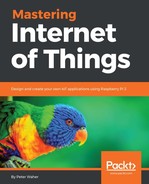Up to this point, we have been satisfied with making our devices communicate using IP-based protocols. We've created our own communication interfaces. Doing so might be simple and a quick way to get started, but it has serious disadvantages: nobody else will be able to communicate without great effort, and we will not be able to use standardized software to help us with our tasks.
In this chapter, we will introduce the concept of application-level interoperability, how standardized technologies can help us in our work. You'll be introduced to Constrained RESTful Environments (CoRE), the Light-weight Machine-to-Machine enabler (LWM2M), a standardized object model for the management of devices based on CoAP and CoRE. IPSO Smart Objects, a set of standardized object interfaces for sensors and actuators, will also be presented. Standardized technologies will allow you to utilize existing software to interact and manage your devices, which in turn will allow you to spend more time on more productive tasks.
The chapter covers:
- An introduction to application-layer interoperability
- The difference between tight and loose coupling
- An introduction to CoRE
- An introduction to the LWM2M object model
- An introduction to IPSO Smart Objects
- An introduction to open software for LWM2M device management
- Publishing sensor data using LWM2M
- Reacting to actuator commands using LWM2M
